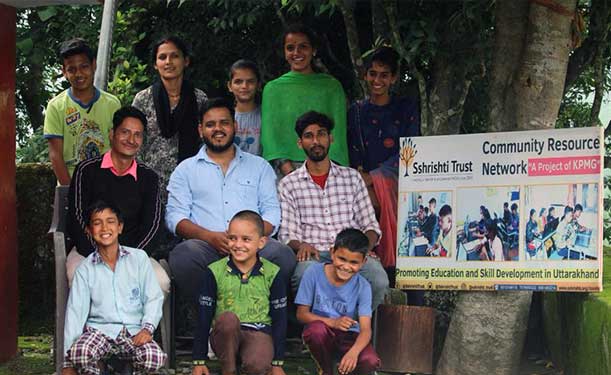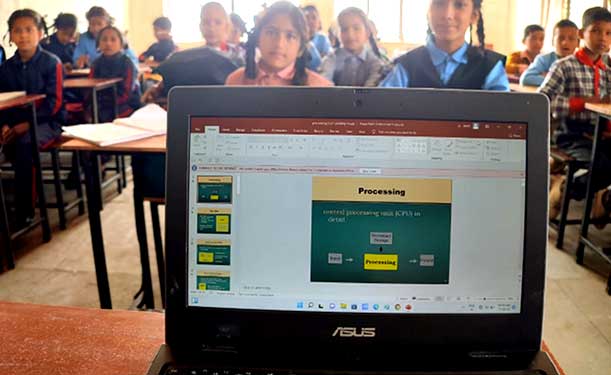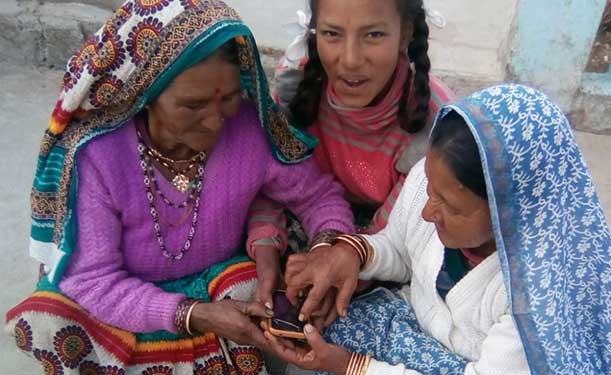Sshrishti’s vision of integrated and holistic development entails Sshrishti’s efforts towards bridging the ever-widening divide in digital literacy. Given post-independent India’s lop-sided development outcomes and the continuing disparity in its planning and implementation, Sshrishti attempts to achieve digital literacy by providing basic, elementary, and advanced training in computer applications to those at the margins of India’s digital revolution who miss out on the associated dividends that bring in better opportunities at employability, communications, and functionality.
At Sshrishti, we hope that digital literacy will not only supplement schooling and education but also foster employability, greatly enhancing the quality of livelihood and possibilities available to youth from marginalized and impoverished communities. It is with these objectives that Sshrishti’s digital literacy programme incorporates:
The programme started in 2008 in a village named Surana in Rajasthan and since then, has covered villages in Haryana, Uttar Pradesh and Uttarakhand. Currently, the project is operational in Delhi and across villages in Uttarakhand. Sshrishti’s digital literacy programme has so far benefited over 10,000 students.
In India, technology is now essential for education and growth. However, many underserved communities still lack proper digital skills. A well-structured digital literacy program can create equal opportunities for children, youth, and women throughout the country.
At Sshrishti Trust, we have seen this change firsthand. By combining digital training with remedial education and bridge courses for students, we help children close learning gaps and gain confidence in both academics and technology.
Digital literacy involves much more than basic computer skills. It includes:
We’ve observed students who were once reluctant to even touch a computer now creating presentations, attending virtual classes, and using e-learning platforms to enhance their skills.
Digital skills are no longer optional; they are essential. A digital literacy program in India provides:
In the government schools, we are integrating technology-driven learning by teaching students to use e-learning platforms and digital tools.
These centres provide access to devices, internet, and structured learning, particularly for students and youth seeking new skills.
These courses assist children who missed classes or dropped out in returning to formal schooling while also learning digital skills.
Youth and women benefit from specialized programs like computer training, financial literacy, and job-oriented courses that prepare them for real careers.
Sshrishti Trust has developed structured offline teaching modules on Microsoft Office tools, Azure fundamentals, Basic English, and core digital literacy skills. These modules are designed for low-connectivity settings and delivered through instructor-led sessions supported by printed materials (if required) and practical exercises. We plan to utilize these proven resources to effectively disseminate digital literacy and skill-building courses among beneficiaries in aspirational districts, ensuring quality, scalability, and impactful learning.
We have an ongoing Digital Literacy project in Uttarakhand since 2015. This project aims at making digital education accessible to local children and youth and addresses their aspirations by providing opportunities for bridge-learning, building proficiency in digital literacy, coding, accounting and Spoken English and relevant life-skills. We run this program through two-ways: Digital Learning Centres and in collaboration with the govt schools
Number of centres: 3
We have a partnership with the Uttarakhand Department of Education to work in the state govt schools. We are currently operating in more than 20 government schools across Almora and Nainital
Courses Offered at our centres:
Curriculum Content in the partnered government schools
Beneficiaries Impacted: 19,000 (2015 - Ongoing)

In the context of India's imminent ascent to economic superpower status, children and youth stand to benefit most from the forces of globalization and digitalization. However, in rural and remote areas, home to over half of the population, digital literacy is nearly non-existent. Some regions grapple with challenges arising from inadequate classroom infrastructure and a scarcity of trained computer teachers, hindering access to digital education. Despite numerous government initiatives for rural beneficiaries, schools are yet to fully embrace the Digital India vision.
Sshrishti's Digital Literacy Programme actively tackles this digital divide by forging partnerships with local government education departments. The establishment of computer labs and community-level digital literacy classes has not only imparted knowledge and hands-on experience in computer technology to students, teachers, and the community but has also empowered them. Our ongoing initiatives are currently operational in Uttarakhand and Uttar Pradesh.
Leveraging the skills of local youth as computer trainers, the program goes beyond fostering digital empowerment; it creates valuable employment opportunities, contributing to a more inclusive and digitally literate society.
Beneficiaries Impacted: 15,000

Started in 2021, stands as a transformative endeavor embodied in Project Himalya Unnati Mission. The primary goal of this initiative is to revolutionize the landscape of skill development and vocational training within the state of Uttarakhand. Specifically targeting five district jails and seventeen government intermediate colleges spanning classes VI to XII, Project HUM signifies a bold step towards providing tangible and meaningful opportunities for skill enhancement and vocational training. This strategic intervention is designed to empower individuals within these institutions, fostering a conducive environment for personal and professional growth. By incorporating modern approaches to skill development, Digital Leap envisions creating a positive impact that extends beyond traditional educational boundaries, promoting a holistic and sustainable framework for the future.
Beneficiaries Impacted: 3,041

Sshrishti Trust has been focussing on modern educational technology tools, including smart classes, Tab Labs, and STEM education, to deliver impactful learning outcomes to students in community-based learning centers, in alignment with the new education policy. In 2017-2018, Sshrishti successfully implemented Google-supported Internet Saathi to bridge the digital divide for rural women in Uttarakhand, providing them with cutting-edge technology to improve their quality of life
Beneficiaries Impacted: 13.5 Lakh

In 2022, Sshrishti secured the Digital Shakti Project, which seeks to distribute Tablets containing the BYJUS premium learning app and Mindspark to 600 government school students, as well as the two educational apps to an additional 150 students who can download them for free. IIM-Ahmedabad researchers are studying the ed-tech learning behavior of the students, while the Sshrishti team is increasing their learning and engagement through motivational nudges, school counseling, and device checks.
The project covered 750 government school students across 83 schools, ranging from 4th to 8th grade, in four blocks. The BYJU's premium learning app and the Mindspark app offer self-study models for remedial coaching in Science, Maths, and SST, with built-in content in English and Hindi, videos, quizzes, and progress reports. The project intends to investigate the students' learning patterns and behavior to create a research-based ed-tech learning model that can be replicated on a larger scale. The Digital Shakti Project is funded by the Central Square Foundation and supported by the ACT foundation for devices, as well as knowledge partners BJYUs and Mindspark, and research partners IIM Ahmedabad .
Beneficiaries Impacted: 750

8 Districts in Uttarakhand: Almora, Nainital, Bageshwar, Champawat, Dehradun, Haridwar, Udham Singh Nagar, Uttar Kashi.
Improved language learning outcomes of Hindi and English among children aged 6-9 years (both school-going and out-of-school) using the BOLO app created by Google.
The App was interactive which was designed to make learning languages interesting and easy, facilitated progressive, faster and long-lasting learning outcomes.
Beneficiaries Impacted: 1,28,000
